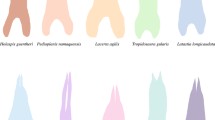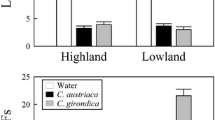Abstract
Experimental tests showed that poststrike elevation in tongue-flicking rate (PETF) and strike-induced chemosensory searching (SICS) in the gila monster last longer than reported for any other lizard. Based on analysis of numbers of tongue-flicks emitted in 5-min intervals, significant PETF was detected in all intervals up to and including minutes 41–45. Using 10-min intervals, PETF lasted though minutes 46–55. Two of eight individuals continued tongue-flicking throughout the 60 min after biting prey, whereas all individuals ceased tongue-flicking in a control condition after minute 35. The apparent presence of PETF lasting at least an hour in some individuals suggests that there may be important individual differences in duration of PETF. PETF and/or SICS are present in all families of autarchoglossan lizards studied except Cordylidae, the only family lacking linguallly mediated prey chemical discrimination. However, its duration is known to be greater than 2-min only in Helodermatidae and Varanidae, the living representatives of Varanoidea. That prolonged PETF and SICS are typical of snakes provides another character supporting a possible a varanoid ancestry for Serpentes. Analysis of 1-min intervals showed that PETF occurred in the first minute. A review of the literature suggests that a pause in tongue-flicking and delay of searching movements are absent in lizards and the few nonvenomous colubrid snakes tested. The delayed onset of SICS may be a specific adaptation of some viperid snakes to allow potentially dangerous prey to be rendered harmless by venom following voluntary release after envenomation and preceding further physical contact with the prey.
Similar content being viewed by others
References
Auffenberg, W. 1981. The Behavioral Ecology of the Komodo Monitor. University Presses of Florida, Gainesville.
Auffenberg, W. 1984. Notes on the feeding behaviour ofVaranus bengalensis (Sauria: Varanidae).J. Bombay Nat. Hist. Soc. 80:286–302.
Beck, D.D., 1990. Ecology and behavior of the gila monster in southwestern Utah.J. Herpetol. 24:54–68.
Beck, D.D., andLowe, C.H. 1991. Ecology of the beaded lizard,heloderma horridum, in a tropical dry rain forest in Jalisco, Mexico.J. Herpeiol. 25:395–406.
Bogert, G.M., andDel Campo, R.M. 1956. The gila monster and its allies: The relationships, habits, and behavior of the lizards of the family Helodermatidae.Bull. Am. Mus. Nat. Hist. 109:1–238.
Burghardt, G.M., andChmura, P.J. 1993. Strike-induced chemosensory searching by ingestively naive garter snakes (Thamnophis sirtalis).J Comp. Psychol. 107:116–121.
Burghardt, G.M., Allen, B.A. andFrank, H. 1986. Exploratory tongue-flicking by green iguanas in laboratory and field, pp. 305–321,in D. Duvall, D. Müller-Schwarze, and R.M. Silverstein (eds.). Chemical Signals in Vertebrates 4: Ecology, Evolution, and Comparative Biology. Plenum Press, New York.
Cadle, J.E. 1988. Phylogenetic relationships among advanced snakes.Univ. Calif. Publ. Zool. 119:1–77.
Chiszar, D., andRadcliffe, C.W. 1989. The predatory strike of the jumping viper (Porthidium nummifer).Copeia 1989:1037–1039.
Chiszar, D., andScudder, K.M. 1980. Chemosensory searching by rattlesnakes during predatory episodes, pp. 125–139,in D. Müller-Schwarze and R.M. Silverstein (eds.). Chemical Signals in Vertebrates and Aquatic Invertebrates. Plenum Press, New York.
Chiszar, D., Radcliffe, C.W., andScudder, K.M. 1980. Use of the vomeronasal system during predatory episodes by bull snakes (Pituophis melanoleucus).Bull. Psychon. Soc. 15:35–36.
Chiszar, D., Radcliffe, C.W., O'Connell, B., andSmith, H.M. 1982. Analysis of the behavioral sequence emitted by rattlesnakes during predatory episodes. II. Duration of strike-induced chemosensory searching in rattlesnakes (Crotalus viridis, C. enyo).Behav. Neural Biol. 34:261–270.
Chizar, D., Radcliffe, C.W., Scudder, K.M., andDuvall, D. 1983. Strike-induced chemosensory by rattlesnakes: The role of envenomation-related cues in the post-strike environment, pp. 1–24,in D. Müller-Schwarze and R.M. Silverstein (eds.). Chemical Signals in Vertebrates III. Plenum Press, New York.
Chizar, D., Radcliffe, C.W., Overstreet, R., Poole, T., andByers, T. 1985. Duration of strike-induced chemosensory searching in cottonmouths (Agkistrodon piscovorus) and a test of the hypothesis that striking prey creates a specific search image.Can. J. Zool. 63:1057–1061.
Chiszar, D., Murphy, J.B., Radcliffe, C.W., andSmith, H.M. 1989. Bushmaster (Lachesis muta) predatory behavior at Dallas Zoo and San Diego Zoo.Bull. Psychon. Soc. 27:459–461.
Cisse, M. 1972. L'alimentation des varanides au Senegal.Bull L'I.F.A.N. 34(A):503–515.
Cooper, W.E., Jr. 1989a. Prey odor discrimination in the varanoid lizardsHeloderma suspectum andVaranus exanthematicus.Ethology 81:250–258.
Cooper, W.E., Jr. 1989b. Strike-induced chemosensory searching occurs in lizards.J. Chem. Ecol. 15:1311–1320.
Cooper, W.E., Jr. 1991a. Discrimination of integumentary prey chemicals and strike-induced chemosensory searching in the ball python.Python regius. J. Ethol. 9:9–23.
Cooper, W.E., Jr. 1991b. Responses to prey chemicals by a lacertid lizard,Podarcis muralis: Prey chemical discrimination and poststrike elevation in tongue-flick rate.J. Chem. Ecol. 17:849–863.
Cooper, W.E., Jr. 1992a. Post-bite elevation in tongue-flick rate by neonatal garter snakes (Thamnophis radix).Ethology 91:339–345.
Cooper, W.E., Jr. 1992b. Elevation in tongue-flick rate after biting prey in the broad-headed skink,Eumeces laticeps.J. Chem. Ecol. 18:455–467.
Cooper, W.E., Jr. 1992c. Prey odor discrimination and post-strike elevation in tongue flicking by a cordylid lizard,Gerrhosaurus nigrolineatus.Copeia 1992:146–154.
Cooper, W.E., Jr. 1993a. Duration of poststrike elevation in tongue-flicking rate in the savannah monitor lizard.Elhol. Ecol. Evol. 5:1–18.
Cooper, W.E., Jr. 1993b. Strike-induced chemosensory searching by a teiid lizard, the golden tegu (Tupinambis nigropunctatus).Chemoecology. 4:79–85.
Cooper, W.E., Jr. 1994a. Chemical discrimination by tongue-flicking in lizards: A review with hypotheses on its origin and its ecological and phylogenetic relationships.J. Chem. Ecol. 20:439–488.
Cooper, W.E., Jr. 1994b. Prey chemical discrimination, foraging mode, and phylogeny, pp. 95–116,in E.R. Pianka and L.J. Vitt (eds.). Lizard Ecology: Historical and Experimental Perspectives. Princeton University Press, Princeton.
Cooper, W.E., Jr., andAlberts, A.C. 1993. Post-bite elevation in tongue-flicking rate by an iguanian lizard,Dipsosaurus dorsalis.J. Chem. Ecol. 19:2329–2336.
Cooper, W.E., Jr., andArnett, 1995. Strike-induced chemosensory searching in the gila monster.Copeia. 1995:89–96.
Cooper, W.E., Jr., andVitt, L.J. 1986. Tracking of female conspecific odor trails by male broad-headed skinks (Eumeces laticeps).Ethology 71:242–248.
Cooper, W.E., Jr., McDowell, S.G., andRuffer, J. 1989. Strike-induced chemosensory searching in the colubrid snakesElaphe g. guttata andThamnophis sirtalis.Ethology 81:19–28.
Dessauer, H.C., Cadle, J.E., andLawson, R. 1987. Patterns of snake evolution suggested by their proteins.Fieldiana (Zool. New Ser.) 34:1–34.
Estes, R., De Queiroz, K., andGauthier, J. 1988. Phylogenetic relationships within Squamata, pp. 119–281,in R. Estes and G. Pregill (eds.). Phylogenetic Relationships of the Lizard Families. Stanford University Press, Stanford, California.
Gabe, M., andSaint Girons, M. 1976. Contribution a la morphologie comparée des fosses nasales et de leurs annexes chez les lepidosauriens.Mem. Mus. Nail. Hist. Nat., Noitv. Ser. A 98:1–87 + 49 figs, 10 pl.
Halpern, M. 1992. Nasal chemical senses in reptiles: structure and function, pp. 423–523,in C. Gans and D. Crews (eds.). Biology of the Reptilia, Vol. 18, Brain, Hormones, and Behavior. University of Chicago Press, Chicago, Illinois.
Hollander, A., andWolfe, D.A. 1973. Nonparametric Statistical Methods. John Wiley & Sons, New York.
Jones, K.B. 1983. Movement patterns and foraging ecology of gila monsters (Heloderma suspectum Cope) in northwestern Arizona.Herpetologica 39:249–253.
McDowell, S.B. 1972. The evolution of the tongue of snakes, and its bearing on snake origins, pp. 191–273,in T. Dobzhansky, M.K. Hecht, and W.C. Steere (eds.). Evolutionary Biology, Vol. 6. Appleton-Century-Crofts, New York.
O'Connell, B., Greenlee, R., Bacon, J., Smith, H.M., andChiszar, D. 1985. Strike-induced chemosensory searching in elapid snakes (cobras, taipans, tiger snakes, and death adders) at San Diego Zoo.Psychol. Rec. 35:431–436.
Radcliffe, C.W., Chiszar, D., andO'Connell, B. 1980. Effects of prey size on poststrike behavior in rattlesnakes (Crotulus durissus, C. enyo, andC. viridis).Bull. Psychon. Sci. 16:449–450.
Schwenk, K. 1988. Comparative morphology of the lepidosaur tongue and its relevance to squamate phylogeny, pp. 569–598,in R. Estes and G. Pregill (eds.). Phylogenetic Relationships of the Lizard Families. Stanford University Press, Stanford, California.
Schwenk, K. 1993. The evolution of chemoreception in squamate reptiles: a phylogenetic approach.Brain Behav. Evol. 41:124–137.
Siegel, S. 1956. Nonparametric Statistics for the Behavioral Sciences. McGraw-Hill, New York.
Author information
Authors and Affiliations
Rights and permissions
About this article
Cite this article
Cooper, W.E., Deperno, C.S. & Arnett, J. Prolonged poststrike elevation in tongue-flicking rate with rapid onset in gila monster,Heloderma suspectum: Relation to diet and foraging and implications for evolution of chemosensory searching. J Chem Ecol 20, 2867–2881 (1994). https://doi.org/10.1007/BF02098395
Received:
Accepted:
Issue Date:
DOI: https://doi.org/10.1007/BF02098395




